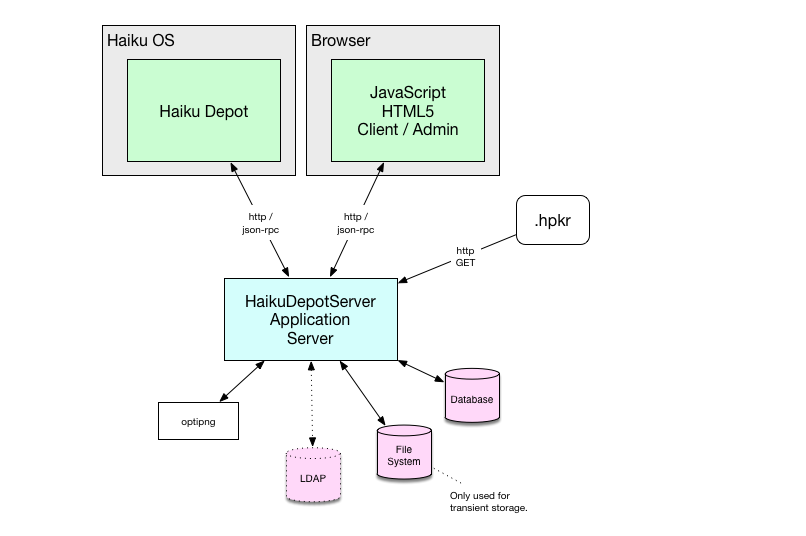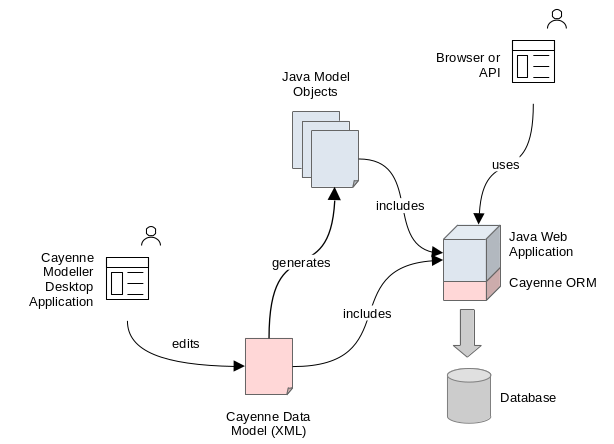Table of Contents
This section covers a broad architectural overview of the system.
The application server deploy product is a self-contained java "jar" file. The application is using the Spring Boot framework and can run itself using an embedded Apache Tomcat server.
The application server communicates (see api) with its clients using the HTTP protocol. The communications are typically RPC style in nature, but also straight GET, POST and other requests are employed where appropriate. The web-front end contains a JavaScript/HTML client that utilizes the same API as is employed by the "Haiku Depot" desktop application running on the Haiku operating system.
The application server will, when prompted or on a poll, import Haiku package repository data from configured Haiku package repositories. To obtain this data it uses HTTP GET requests to obtain the ".hpkr" files from each repository.
The application server stores all of its core data in a database. It also uses local storage for temporary data storage.
The application server uses the "optipng" tool on the deployment host in order to optimize image data.
The application server uses a number of technologies to provide infrastructure for the application server. The application server is based on SpringBoot technology. You can find out more about those APIs in this document.
The application server uses SLF4J to provide for logging. Other common logging frameworks are re-plumbed into SLF4J in order to centralize logging management.
The object-relational mapping (ORM) technology used in the project is Apache Cayenne. Apache Cayenne has a different transaction-handling approach to other common java ORM solutions. It maintains an in-memory model of the changes made in a context and then flushes those changes to the database when the context is committed. For this reason, there is no notion of a "database transaction per request". The entities are described in a model file [1]. "cayenne-haikudepotserver.xml" and the java objects that represent those entities in the running application are in the java package "org.haiku.haikudepotserver.dataobjects". The application server has no formal DAO layer; queries are simply made from the ORM context. Static methods on concrete entity objects provide easy access to common queries and various services such as "PkgIconService" and "PasswordResetService" provide higher level functionality in various logical areas of the application.
Using the Cayenne "listeners" such as PostAddMutableCreateAndModifyTimestampListener and UserRatingDerivationTriggerListener the system is able to use changes to entities as a trigger to perform tasks such as update the create and modify timestamp attributes on entities.
Caching data uses the Cayenne query caches. These are defined on the "HaikuDepot#CacheGroup" enum and are used in various Cayenne queries. An example would be on "PkgIconImage#findForPkg(..)". The caches are cleared by listening for any change on the entity by using a listener. These are configured as Spring beans in the "persistence.xml" file. This is fairly liberal cache eviction, but will work well for the time being.
On first-use the application server will populate the database schema-objects (tables, sequences and so on) itself. It does this with a library called Flyway. Later, as new versions of the application server are deployed, the application server will detect that a database upgrade is required and run the necessary migration scripts. The migration scripts can be found in the source-code at "/haikudepotserver-webapp/src/main/resources/db/..."
The multi-page web interface is designed to provide a simplistic web experience with reduced features for lower-end browsers that have limited JavaScript support. This interface is public-facing only in that it is not possible to meaningfully authenticate with the system when using the multi-page web interface. This interface is constructed with the Spring MVC framework and Thymeleaf templating. Pages are rendered server-side and delivered to the web browser.
The single-page interface is the primary web-based user interface for the system. It provides functionality directed at public (unauthenticated), authenticated, administrative and root users. This interface is built using HTML and JavaScript in a "Single Page Application" (SPA) architecture. The SPA interface uses the exact same APIs as the desktop Haiku Depot application and so is a true client of the application server.
The whole system is treated as "full stack" and so the application server as well as the single-page interface are part of the same project and the same build-product. The application server serves the resources required for the single-page interface.
The interface is driven by the AngularJS JavaScript framework. This framework provides for browser-side page rendering, navigational flow. You can find the AngularJS-centric resources at "/haikudepotserver-webapp/src/main/webapp/js/app/...". AngularJS is no longer supported.
The "user state" including who is authenticated is stored in an AngularJS service within the browser's local storage. The user state is not stored server-side in a "session" and the user's browser does not maintain reference to a cookie. The user's authentication is instead communicated to the server based on a signed token. The token has an expiry and so needs to be periodically refreshed. Because of this, the user state logic in the client will communicate with the server to refresh the user's token from time to time.
Details about localization can be found under application localization.
Where possible, images used in the user interface are provided as SVG so that they can be rendered in a resolution-independent manner.
See the security section for an overview of the authentication and authorization from the perspective of a user.
Although the core Spring Framework is used, Spring Security is not employed in this application server in order to keep the security infrastructure relatively simple.
A servlet filter, AuthenticationFilter exists in the filter-chain in order to intercept any HTTP requests and, where appropriate, to detect an authentication. If an authentication fails, the filter will not specifically respond; the request will proceed without a user associated with it. If an authentication is successful then the user is stored in a thread local such that it may be accessed in downstream logic. Authentication options include both Basic (base 64 username and password pair) as well as a token mechanism.
API exists for answering queries relating to authorization. The AuthorizationApi endpoint provides these services. In this way clients are able to check for permissions to undertake operations on some resource. The types of resources are;
- Package
- User
- Repository
- User Rating
These are typically referenced by their natural or artificial identifier. In the case of a package this would be the name of the package (eg; "git", "bemail"). In the case of a user rating, this would be the user rating's code (eg; "FA91FA34-D0BE-47A2-8114-CE33CACAE533").
Permissions are defined on the "Permission" enum. Examples of permissions include;
- REPOSITORY_EDIT
- USER_CHANGEPASSWORD
- PKG_EDITPROMINENCE
The client is expected to hide or show options or data in accordance with a user's security situation, but the application server will also enforce authorization server-side as the client uses API in the system.
Permissions related to packages can be configured in the database on the PermissionUserPkg entity. Users can be assigned either a specific permission across all packages or for a specific package. This way if a user is an owner of a package then they can be assigned special permissions on that package.
Email outbound from the application server includes;
- Forgotten password
Email is delivered with the Spring Framework's email support. The email templates are produced with the Freemarker library. The templates for the emails are located at "/haikudepotserver-webapp/src/main/resources/mail/...".
The application must perform various background jobs from time to time that are impractical to have occur as part of an HTTP request or that are initiated from a process other than an HTTP request. These are known as "jobs". Examples of situations where jobs are required include;
- Importing repository data
- Generating a report of localization coverage
- Importing a tar archive of package icons
The figure above shows a number of the key classes that form the functionality of the jobs system. For each new job, there needs to be a concrete subclass of JobRunner and a corresponding concrete subclass of JobSpecification. Together these provide a means of defining the parameters of the job and a means of running the job.
In general, manipulating, enqueueing and querying jobs is done through the JobService. The service will typically return results of type JobSnapshot to indicate the status of the running job. The JobSnapshot instance is immutable. A job is identified by a GUID. An example of a GUID would be "98F4B8C0-2F42-4233-813D-AB90C60F6717".
As a job progresses, it moves between a number of states;
- INDETERMINATE
- QUEUED
- STARTED
- FINISHED, FAILED, CANCELLED
The "JobSnapshot" will convey both the state and also the time at which a state transition occurred.
Some jobs require data inputs and outputs. An example might be a package category import job. Such a job requires that a CSV file of changes is supplied and the job will export a new CSV file with a list of the changes made. These input and output files are managed by the JobService and can be referred to by a GUID.
The JobSpecification object will maintain a GUID for the supplied input data. The supplied input data can be populated into the JobService ahead of creating the JobSpecification. Various methods are exposed on the JobService to support the manipulation of job data.
The JobService keeps track of generated output data and its association with a given job.
As the application server may be running a number of jobs over time, these would pile-up in the memory of the application server and data related to these reports would pile-up in storage. To avoid this, jobs have a time-to-live which is specified as an attribute of the JobSpecification.
API specific to each JobRunner / JobSpecification is provided in order to allow a job to be started from the web interface.
The JobController is able to allow the client to upload supplied input data and for the client to download generated output data via HTTP POST and GET requests respectively.
The application server is able to produce Atom or RSS feeds that can provide updates relating to packages. The feeds are in the context of one or many packages. These are produced by the FeedController class which uses the Rome library to render the feed to XML. See the FeedService for further details about this process.
For some operations such as creating a user or changing password, it is necessary to verify that the user is a human operator and not a machine. To achieve this, a pictographic representation of a puzzle is shown to the user. This has a simple textual response. A mechanism for this is in the "org.haikudepotserver.captcha" package.
A typical use pattern will involve the client first creating a captcha. This creation process will yield a token for the captcha as well as an image to display to the human operator. When the second API is used that requires the captcha response, the client's call will contain both the textual response from the human operator as well as the token to identify the captcha.



